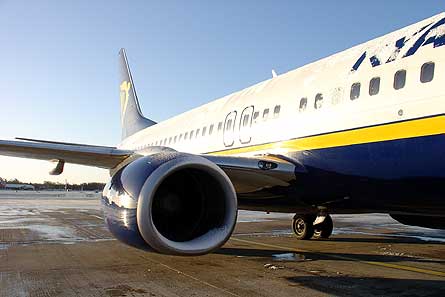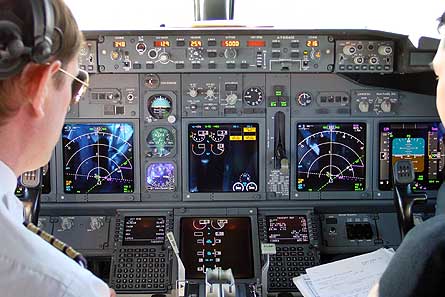The low-cost airline is offering a new rostering arrangement that gives flightcrew more time off – but is there a catch?
One of the many paradoxes about Ryanair is that, on the face of it, its pilots are well paid and have a roster that ensures they work hard but get lots of time off; but there is always dissent in the ranks. Meanwhile, the airline provides the lowest fares in Europe and as a result people flock to fill its aircraft. Yet the media seem always to be looking for the safety corner-cutting that they reason must be what enables the carrier to charge bargain basement fares.
The airline is negotiating with its pilots a new rostering deal that looks as if it will give them more time off (Flight International, 7-13 March). Despite this, the pilots still demur. Head of air and ground operations David O’Brien is reluctant to talk about the deal except to concede that negotiations are in progress and that their basis is a move from the present rostering pattern of five days duty followed by three days off to five on/four off. No other airline matches this kind of deal, so why do the pilots not snap it up? Chief financial officer and deputy chief executive Howard Millar agrees that the airline hopes to get concessions from the pilots in return for such apparent generosity, but again he will not spell out what sort of concessions he has in mind. For an airline that publishes its balance sheet and business plans on its website and is as transparent a business as anything out there, the internal machinations are more difficult to fathom.
|
| Ryanair's rapid fleet expansion is making many question whether it faces a pilot shortage |
Since Ryanair does not recognise trade unions, the employees can only make their voices heard outside the airline covertly, which makes the quality of the information provided more difficult to check. Reliable internal sources, however, indicate that some of the concessions the airline seeks in return for the 5:4 duty/time off ratio would – if agreed – entail designating some of the additional days off as annual leave or forms of duty that do not involve line-flying, like recurrent training or medicals. Certainly the proposition, as it stands now, is represented thus on the Professional Pilots Rumour Network internet forum. As some pilots see it, any such agreement would reduce their control over their private time and not represent the net time-off benefit it appears to be.
The talks with the pilots are being conducted via employee representative committees (ERC) at the airline’s bases, says O’Brien, adding that the carrier also holds periodic “town hall” briefings for its employees about business policy and performance, which end with a question and answer session that is “usually robust”. The only detail O’Brien will venture is a generic statement about the constant factors in negotiations with employees: he names these as quality of life, money, and job security, and says the company is trying to reach a medium- or long-term agreement with crews that would meet their objectives realistically in the current business environment.
It is difficult to persuade the company to clarify its reason for offering a 5:4 roster. Millar concedes that the existing pilot rostering system is so effective in terms of getting duty hours out of the flightcrew that some of the pilots complete their 900h maximum allowable annual crew duty time in less than 12 months, and have to take the remainder of the year as gardening leave.
He suggests there is evidence of pilots who, when approaching the limit and therefore extended time off, “make a dash for the finishing line”. O’Brien, however, is unwilling to concede that this is a problem for the airline, insisting that Ryanair has never had a better crew/aircraft ratio.
But chief pilot Ray Conway’s own experience suggests the situation is not so simple. Conway acknowledges that, at present, he is doing more line flying than he usually does as the airline’s non-rollover rostering year approaches its 31 March end. Crew pressure peaks in March because some of its pilots reach their 900h annual maximum in 10 or 11 months, he says. Some pilots claim nine months is not rare.
If that happens, the pilots are effectively on holiday until 1 April. These absences from the roster are partially offset by low-season schedules, says Conway, but since Ryanair’s operations are not particularly seasonal, the compensation is not complete. A five days on/four days off ratio would, in theory, spread crew hours more evenly over a 12-month period. But none of the senior executives will confirm whether this is their primary reason for floating the 5:4 ratio.
Pilot shortage?
O’Brien denies the widespread rumours that the airline is short of pilots as a result of its rapid expansion. Conway was one of those who travelled to Seattle last week to take delivery of Ryanair’s 100th Boeing 737-800. The carrier has now retired the last of its 737-200s, and O’Brien says its fleet will be expanding by a net total of 30-40 aircraft a year.
The total firm order with Boeing is for 239 Next Generation 737s, leaving 139 yet to be delivered. To man the aircraft, says O’Brien, the carrier will be recruiting 300-400 pilots a year, but he claims the airline is not having to “chase down” 737 pilots and insists there is “no evidence that the source of [fully qualified] commercial pilots is drying up”. He concedes that for two more years Ryanair will have to hire some direct-entry captains, but then promotion from within should fill the command posts that become available. Conway says that in the last 12 months Ryanair has taken on 300 new pilots, and filled 150 commands and 40 additional training posts.
There is "no evidence that the source of commercial pilots is drying up" |
DAVID O'BRIEN, RYANAIR |
A sign of the times is that, at present, some recruited pilots do not have to pay for their own type ratings: these include direct entry captains and senior first officers who are judged to be ready for command within a short period. The latter might be turboprop captains who join Ryanair as first officers. But although they do not pay up front, the pilots are bonded to repay the training cost over five years. Low-time first officers still pay €25,000 ($30,000) up front for their type rating if they do not already have one.
The most recent “unfriendly” press coup against Ryanair was accomplished by UK television network Channel 4 in its Dispatches documentary in February. Channel 4 managed to embed some of its reporters with the airline as cabin crew and covertly film day to day scenes. This revealed some serious failures in the cabin crew training organisation, which implied that the system was set up so no-one could fail the course. Also, some inaccurate technical information was provided to cabin crews by training staff, and there were shortcomings in passenger identity checks at some boarding gates.
The programme showed the difficulties for cabin crew in clearing and cleaning the cabin during Ryanair’s trademark 25min turnarounds. But generally the programme’s revelations were unsensational. Millar comments on how “the Dispatches programme ran like wildfire through the organisation”, noting it had sharpened up some crew procedures “better than any company briefing could do”.
The one thing that no-one argues about is Ryanair’s business success. Its results feel relentlessly predictable: the last reported quarter showed passengers up 26%, revenues up 27% and a 20% net profit margin. Ryanair is certainly a fearsome, unstoppable machine as seen by its competitors, and Millar observes that “there are still vast swathes of Europe we don’t cover”. Millar says rivals have “been withdrawing from [direct or close] competition because there is no point”. So far its growth has not been affected by the fuel price spiral, but Millar points out that its fuel price hedging arrangements are just about to end and will resume “when the opportunity arises”. Meanwhile, fuel – which Howard says is now 35% of the airline’s total cost base – has pushed total unit costs up by 7%. This does not alter the fact that its cost per passenger journey – at €39 – was still the lowest in the market by far in the final quarter of 2005, and its revenue per passenger exceeded that by €9.
|
| Some of Ryanair's crew are completing their 900h in 10 months; before spending the rest of the year on leave |
Conway calls the airline “a well-oiled machine”. Its operations model depends on predictability and, although the airline varies its employee contracts to take advantage of the different circumstances and costs at all 15 of its bases, the operational template at all of them is identical, he points out. Punctuality is one of the intended products, and Ryanair leads the on-time field compared with other European airlines, according to the Irish civil aviation authority.
The operating system is simple. Each aircraft departs from its base on the first wave of flights early in the day, and by the end of the operating day all crew and aircraft are back home. There is no scheduled overnighting away from base, so flight and cabin crews get a more predictable family life than most airline employees can hope for, with rosters published a month in advance. Since all aircraft are at base overnight, fault fixing is easier.
Disciplined system
It sounds idyllic, but actually is highly disciplined with virtually no slack in the system. Turnarounds are scheduled to take 25min, and any delays are subject to immediate scrutiny. Pilots say if the cabin is absolutely full – the average third quarter load factor was 83% – 25min is impossible, and they rely on arriving early at the gate to achieve on-time departure. If any aircraft become unserviceable, Ryanair has four standby aircraft in its fleet: at present there is one based at Dublin, one at Rome Ciampino and two at London Stansted.
Daily at 08:00 Dublin time, after the first wave of departures, which is completed within 90min, all 15 base operations chiefs join up in a conference call. This is preceded by each centre sending an email to the Dublin headquarters detailing performance. If there is an identifiable reason even for a one-minute delay it is discussed to see if a recurrence can be prevented, says deputy director of operations Shay Warren. Conway explains the purpose of this is not punitive; it is the system for fine-tuning the Ryanair machine. At 08:30 every Monday at the Dublin headquarters, all department heads meet Ryanair chief executive Michael O’Leary and review the week’s operational performance. Nothing gets missed.
This is the environment in which Ryanair pilots work. But despite the hard work, Ryanair’s predictable lifestyle through the five on/three off roster system still attracts applicants from all over Europe. The question is, why is Ryanair – the airline that gives nothing away – offering them a deal that looks, on the face of it, even better?
DAVID LEARMOUNT / DUBLIN
Source: Flight International

























